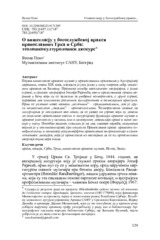Приказ основних података о документу
О вишегласју у богослужбеној пракси православних Грка и Срба: теолошкокултуролошки дискурс
On the Multipart Singing in the Religious Practice of Ortodox Greeks and Serbs: The Theological-Culturological Discourse
| dc.contributor | Јовановић, Јелена | |
| dc.creator | Пено, Весна | |
| dc.date.accessioned | 2018-09-12T13:46:45Z | |
| dc.date.available | 2018-09-12T13:46:45Z | |
| dc.date.issued | 2014 | |
| dc.identifier.issn | 1450-9814 (print) | |
| dc.identifier.uri | https://dais.sanu.ac.rs/123456789/3884 | |
| dc.description.abstract | Појава вишегласне црквене музике у православним храмовима у Аустријској царевини, током XIX века, изазвала је још један у низу спорова међу помесним црквама на Балкану. Преписка између васељенског патријарха, с једне стране, и српског патријарха Јосифа Рајачића, као и представника грчких верника у Бечу који су се залагали за увођење четворогласа, с друге стране, одражава два суштински различита културолошка и еклисијална приступа. Први се условно може назвати „источним” – традиционалним, док је други недвосмислено „западни” – просветитељски. Четворогласно певање на литургијама је послужило као повод да се укаже на узроке који су довели до подељене православне свести о литургијској функцији црквене музике и црквене уметности у целини, али и целокупног доживљаја цркве и њене мисије у свету. Посебан акценат стављен је на два, свакако највећа, искушења којима је у поствизантијској ери подлегла Православна црква: црквеном етнофилетизму и латинској псеудоморфози православне антропологије и самог теолошког дискурса, која је проистекла из настојања да се од прозелитских насртаја очува вера отаца. | sr |
| dc.description.abstract | In 1844, Serbian patriarch Josif Rajačić served two central annual Liturgies, at the feasts of Pasha and Penticost, in the Greek church of Holy Trinity in Vienna; these were accompanied by the four-part choral music. The appearance of new music in several orthodox temples in Habsburg Monarchy (including this one) during the first half of the nineteenth century, became an additional problem in a long chain of troubles that had disturbed the ever imperiled relations between the local churches in Balkans, especially the Greek and Serbian Orthodox. The official epistle that was sent from the ecomenical throne to all sister orthodox churches, with the main request to halt this strange and untraditional musical practice, provoked reactions from Serbian spiritual leader, who actually blessed the introduction of polyphonic music, and the members of Greek parish at the church of St. George in Vienna, who were also involved with it. The correspondence between Vienna and Constantinople reflected two opposite perceptions. The first one could named “traditional” and the other one “enlightening”, because of the apologies for the musical reform based on the unequivocal ideology of Enlightenment. In this article the pro et contra arguments for the new music tendencies in Greek and Serbian orthodox churches are analyzed mainly from the viewpoint of the theological discourse, including the two phenomena that seriously endangered the very entity of Orthodox faith. The first phenomenon is the ethnophiletism which, from the Byzantine era to the modern age, was gradually dividing the unique and single body of Orthodox church into the so-called “national” churches, guided by their own, almost political interests, often at odds with the interests of other sister churches. The second phenomenon is the Westernization of the “Orthodox soul” that came as a sad result of countless efforts of orthodox theological leaders to defend the Orthodox independence from the aggressive Roman Catholic proselytism. “The Babylonian captivity of the Orthodox church”, as Georg Florovsky used to say, began when Orthodox theologians started to apply the Western theological methods and approaches in their safeguarding of the Orthodox faith and especially in ecclesiastical education. In this way the new cultural and social tendencies which gripped Europe after the movements of Reformation and Contra-Reformation were adopted without critical thinking among Orthodox nations, especially among the representatives of the Ortodox diaspora at the West. Observed from this extensive context, the four-part music in Orthodox churces in Austria shows one of many diverse requirements demanded from the people living in a foreign land, in an alien and often hostile environment, to assimilate its values, in this case related to the adoption of its musical practices. | en |
| dc.language.iso | sr | sr |
| dc.publisher | Belgrade : Institute of Musicology, Serbian Academy of Sciences and Arts | sr |
| dc.relation | info:eu-repo/grantAgreement/MESTD/Basic Research (BR or ON)/177004/RS// | sr |
| dc.rights | openAccess | sr |
| dc.rights.uri | https://creativecommons.org/licenses/by-nc-nd/4.0/ | |
| dc.source | Музикологија / Musicology | |
| dc.subject | црква | sr |
| dc.subject | нација | sr |
| dc.subject | Срби | sr |
| dc.subject | Грци | sr |
| dc.subject | вишегласна црквена музика | sr |
| dc.subject | Исток | sr |
| dc.subject | Запад | sr |
| dc.title | О вишегласју у богослужбеној пракси православних Грка и Срба: теолошкокултуролошки дискурс | sr |
| dc.title | On the Multipart Singing in the Religious Practice of Ortodox Greeks and Serbs: The Theological-Culturological Discourse | en |
| dc.type | article | sr |
| dc.rights.license | BY-NC-ND | sr |
| dcterms.abstract | Peno, Vesna; O višeglasju u bogoslužbenoj praksi pravoslavnih Grka i Srba: teološkokulturološki diskurs; | |
| dc.citation.spage | 129 | |
| dc.citation.epage | 153 | |
| dc.citation.volume | II | |
| dc.citation.issue | 17 | |
| dc.identifier.doi | 10.2298/MUZ1417129P | |
| dc.description.other | Студија је резултат рада на пројекту Идентитети српске музике од локалнихдо глобалних оквира: традиција, промене, изазови (ОН 177004), који финансира Министарство за просвету, науку и технолошки развој Републике Србије. Посебну захвалност дугујем управнику Архива САНУ у Сремским Карловцима, Жарку Димићу и архивару Дијани Милиновић, који су ми омогућили да у кратком рокудобијем наручену архивску грађу употребљену у раду, као и библиотекару Археографскогодељења народне библиотеке Србије, мр Љиљани Пузовић, чијомдобротом је до мене стигао фотокопиран материјал. | sr |
| dc.type.version | publishedVersion | sr |
| dc.identifier.fulltext | https://dais.sanu.ac.rs/bitstream/id/12357/bitstream_12357.pdf | |
| dc.identifier.rcub | https://hdl.handle.net/21.15107/rcub_dais_3884 |

